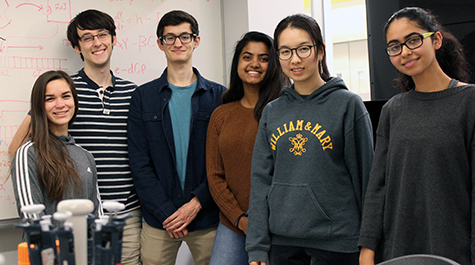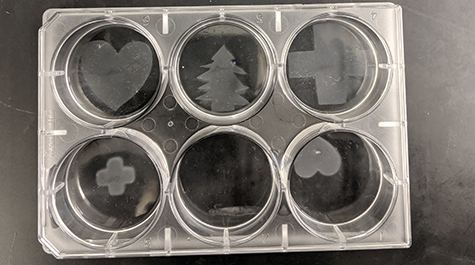W&M iGEM team develops biofilms for materials made of living cells
The next big thing in materials science may already be here – and it’s clogging up your showerhead.
“Next time you take a look at the gunk in there, think ‘biofilm’ and think ‘the future of material engineering,’” said Margaret Saha, Chancellor Professor of Biology at William & Mary.
Biofilms are the focus of this year’s W&M iGEM team – the acronym stands for International Genetically Engineered Machine. The group of undergraduates is preparing to compete in the world’s largest synthetic biology competition for the sixth year in a row. Saha has served as the iGEM faculty advisor for all six years.
Their goal this year is to create a living, programmable coating made of an engineered biofilm. Things that are living are not usually programmable, but that is exactly what iGEM is all about. Each iGEM team receives a starter kit of BioBricks, an assortment of biomolecular components that can be assembled into biological circuits, much as an electrical engineer assembles resistors and diodes into circuits.
Over the summer, the team develops ways to use BioBricks and other new parts they’ve designed to build biological systems and operate them in living cells. This year, they plan to use engineered biofilms as a basis for living biomaterials.
The team has mainly been working with E. coli and has developed a toolkit for a robust, programmable E. coli biofilm. They are also working with Mycobacterium, with the aim to make this species a new chassis for biofilm-based materials.
It’s no small task. The biofilm has to be strong enough to be useful in a wide array of applications, like coating metal or dressing a wound, and it has to be tame enough to stay where it is placed.
“Control is one of the key aspects of this project,” said Julia Urban ’21, who serves as a co-captain for the team. “If you are using this material in the real world, and it’s a living organism, you better be able to control it.”
The team has already created biofilms that will take on defined patterns when subjected to blue light. For example, they projected blue light in the form of a star and biofilm took the exact shape of the projected star. They coded genes inside the bacterial biofilm to express an adhesion protein, or phenotype, that made the cells form patterns when exposed to a certain wavelength of light.
“We have that level of spatial control,” Urban said. In addition to Urban, the team members are Adam Oliver ’21, Xiangyi Fang ’21, Beteel Abu-Ageel ’22, Sanjana Challa ’22, Elias Nafziger ’22, Hanqiu Peng ’20, Vivian Zhu ’20 and Anna Isler ’22.
The W&M project will be judged against other projects from major research institutions throughout the world at the iGEM Giant Jamboree starting Oct. 31 in Boston. The winner will take home what’s been called the “World Cup of Science.”
It’s a championship title the university has claimed before. A William & Mary team won the iGEM Grand Prize in 2015, was first runner-up in 2017 and has medaled in all of the iGEM competitions they’ve entered.
The competition requires students to be engineers, chemists, biologists, mathematicians and computer scientists all at once. It’s how science is done in the 21st century — team-based, multidisciplinary, quantitative and focused on finding solutions to difficult problems.
This year's team is comprised of students majoring in Kinesiology & Health Sciences, Biology, Mathematics, Computer Science and Computational & Applied Mathematics & Statistics (CAMS). And they're aiming higher than a win at the Giant Jamboree.
The blue light experiment was just the beginning, Urban explained. A team of researchers at Stanford recently engineered bacteria into an optically responsive, patterned biofilm. The W&M iGEM team successfully replicated that experiment in the lab and saw how they could improve the results. They decided to take it a step further and engineer a biofilm that can withstand life beyond the lab.
“Our project began by using this construct we got from the Stanford bioengineers, but we found early on that the protein they used formed weaker biofilms. It wasn’t strong enough,” Urban said. “One focus of our project is to develop a library of sticky proteins, known as adhesins, to make the film stronger, so it is available for real-world applications.”
Another facet of the project has been developing ways to pattern biofilms, so the bacteria within them can divide up and perform different tasks. Biofilms refer to bacterial communities and the extracellular matrix they form inside, co-captain Xiangyi Fang explained. Biofilms can be patterned so that the bacteria within them divide up and perform a variety of tasks.
“It’s a form of division of labor,” Urban said. “You can have different things going on in the biofilm at one time. If we’re trying to mimic real-life systems, like using a patch of biofilm to heal a wound, it would need to be able to respond to different aspects of that process.”
A major perk of dividing up cellular labor is that one cluster can be responsible for maintenance, explained co-captain Adam Oliver. Patterning will make it possible for bacteria within the biofilm to respond to signals that the film is weakening and work to repair it.
“If you think about it, all materials are just chemicals,” Oliver said. “You create a material and, over time, it erodes away. But living materials are able to self-repair and self-replicate. We’re so used to the idea that you have to replace coatings on metals, but if you had these biofilm materials, they could just repair themselves.”
Urban, who was on last year’s iGEM team along with Oliver and Fang, said an invited speaker at the Giant Jamboree made a comment that stays with her today. He projected a photograph of his desk. There was a computer, a smartphone and a houseplant on top of it. He asked the audience to identify the most sophisticated technology in the photo.
“It’s the house plant,” Urban said. “The living organism will always be able to do more and respond to the environment in a way that your computer won’t. If it gets broken, it can repair itself. I think this is the future.”
 Skip to main content
Skip to main content


